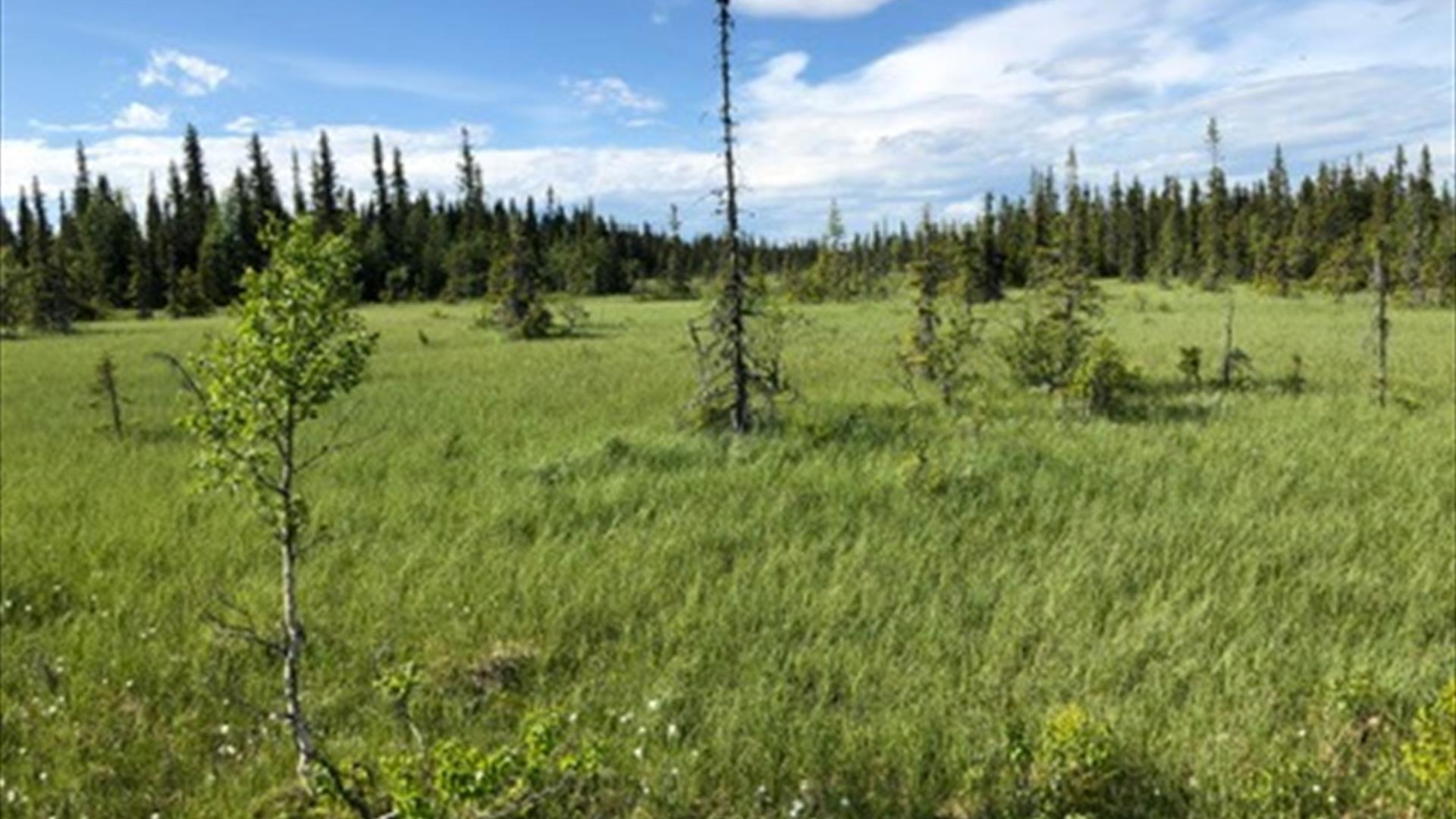About
"Distance: Storstilen round-trip: approx. 18 km. Suitable for: Excellent family outing. Suitable for all. The stories about Sjuguttsteinen by Stenstilen and Berthe Putta at Nøkkelåsen add extra excitement for the young. This route covers three authentic mountain farms with approx. three kilometres between each. Gentle terrain all the way. Storstilen, one of the largest mountain-farm areas in the Ringsaker mountain, is a perfect starting point. The scenery and cultural landscape alone are more than enough reason to visit, but the trip comes with the added bonus of the “Berthe Putta” story and the “Sjuguttsteinen” legend. Children in particular will find these stories exciting. But first and foremost, when you park at Storstilen there is a welcome committee – a flock of bleating sheep. With a kind word and a scratch behind the ear, you will make friends immediately. Storstilen The Storstilen summer pastures belonged to farms at both Nes and Ringsaker, and had road connection from as early as 1881 when Thorevegen, which is today’s Birkebeinervegen, was built. When the mountain road from Bergundhaugen came ten years later, it was linked with Thorevegen. This reduced the distance from the village by 4-5 kilometres and thus became the most popular route. From 1900 onwards, mountain dairy farming was in decline and the first farmhouses were sold as holiday homes. Some, however, kept going until the 1960s. Kjos-setra, located at Storstilen, is some 100 years old, and was co-owned by the farms Kjos and Sæter at Ring. The old Thorevegen originally ran between Kjos-setra and Nord-Vea. Down the hill by the stream, there was a shared water-house where the milk was brought for cooling and, during the post-war years, collected by the milk truck. From Storstilen to Stenstilen and onwards to Nøkkelåsen At the junction by Storstilen, turn left towards Ljøsheim. Follow the dirt-road, and before you know it you are at Stenstilen. Continue a few metres to the right, and you will reach an open landscape with a beautiful mountain farm. Take a closer look at the old barn where generations of farmers have toiled. Imagine the sheer number of cows that have passed through this door – and the amount of milk that has been produced. Continue to Nøkkelåsen and the story about “Berthe Putta” Some three kilometres from Stenstilen, you will see the sign for Nøkkelåsen. There is a short climb along the way, but nothing too challenging. After one or two kilometres uphill, you will glide into the stunning cultural landscape of Nøkkelåsen. This is an area truly worth exploring. Take a stroll and imagine bygone days when this was a vibrant community of people and animals. The farm by the edge of the forest is maybe the oldest at Nøkkelåsen – and the perfect spot to enjoy your packed lunch as you take in the spectacular views of the colourful and stunningly beautiful landscape. “Berthe Putta” – woman, man… and hulder Berthe Puttenberg (1854-1928) brought her animals to the pastures at Nøkkelåsen for many a summer. People called her Berthe Putta, and she was renowned for her excellent farming skills. She was also widely known for her delicious sour-milk cheese and exquisite butter. However, Berthe was very different from other women. Ambiguous gender She preferred what was considered men’s work, she had a deep voice, and she was stronger than many of her male counterparts. Berthe always did the heavy lifting, and she had a body built for this. She was big and strong, with sturdy arms and legs. Her voice was deep and her jaw masculine. When she was born, it was said, her parents did not know whether to give her a girl’s or a boy’s name. They chose Berthe to avoid any confusion when she was old enough for national service. Her gender ambiguity was in many ways a personal tragedy and impacted her entire life. Never in public without a headscarf Berthe always wore a headscarf – and she was very particular about its appearance. The knot always sat just under the chin. If it slid down, she quickly put it back in place. One of the few who perhaps saw her without a headscarf was Anders Nordhagen who claimed to once have spotted Berthe having a wash outside. She had removed her headscarf, and he noticed a dark ring of hair around the lower back of her head and on both sides of her chin. Apart from this, she was completely bald. Believed to be a hulder She was once taken for a hulder – a folklore forest creature – here at Nøkkelåsen. Her horse was missing, and she had to go out searching. It was a miserable day – grey and foggy. Two men who had been fishing nearby suddenly saw a woman in a long skirt and headscarf, with a halter around her neck, appearing from the fog. They stopped dead in their tracks, and just as suddenly as she had appeared, she vanished back into the fog. The men were convinced that they had seen the hulder, and their story was wide and far. Awarded the King's Medal of Merit Berthe leased the mountain farm, and when she arrived at Nøkkelåsen it was in poor condition with no fencing and few buildings. With some help from the men known as “Langsvestugukara”, she had soon added a new barn, shed, and smokehouse (for cooking, baking, and washing). The barn and smokehouse erected by Berthe are still standing. In addition to her own animals, she also brought with her livestock from other farms. When Berthe was 70 years old, she received the King's Medal of Merit for her farming work. She was visited by a journalist from the Aftenposten newspaper who asked her to wear the medal for a photo – but this Berthe Puttenberg refused! Between Stenstilen and Storstilen – the Sjuguttsteinen legend When you have finished your packed lunch, had your coffee, and are rolling back down from Nøkkelåsen whilst digesting the story about “Berthe Putta”, you have the return trip to Storstilen to look forward to. Some 2-300 metres before you reach the Storstilen junction, there is an optional detour to the legendary Sjuguttsteinen. As the story goes, this was the scene of a grazing land dispute between seven shepherd boys in July in the year 1600. To settle the quarrel, they agreed a duel. The weapons were sharpened juniper sticks that were left in the sun until they were hard as bone. On the day of the duel, they met on the marsh where they appointed an official. His name was Zacharias, and he was the eldest of the boys. They fought each other, three against three, and kept going until everyone except one had lost their lives. He accused Zacharias of poor officiating, and soon they too were fighting for life and death. Zacharias was killed, and the surviving shepherd crawled to Stenstilen where he died from his injuries. This story has been told for almost 400 years. What do you think? Could it have happened? Sjuguttsteinen is on the left by the open marches when coming from Nøkkelåsen. There is a sign by the roadside, and there is a walkway across the marsh. Final effort When you have visited Sjuguttsteinen, it is not far to Storstilen where the car awaits. As you reach the farm, you will see that it has been well guarded during your absence. It will most likely be surrounded by 5-10 sheep lying comfortably on the ground, and they will happily ignore your efforts to make them move. Just to be safe, when your bicycles are securely fastened to the carrier and you are ready to head off, check under your car before you go... Source: “På gamle stier imilla Mjøsen og Messen”. Brøttum Historielag, 1984 lommekjent.no Text: Åse Kari Gravråk" javascript:__doPostBack('ctl00$Main$btnSave','')
Facilities
Age limit
- adult oriented
Distance
- length in km - 18 km
Duration
- 3 hours
Grading
- easy
Nature and terrain
- asphalt
- gravel
- major pathway
- mountainous terrain
- small path
Season
- June - October
Sports activities
- not illuminated trail
.png)
.png)



















